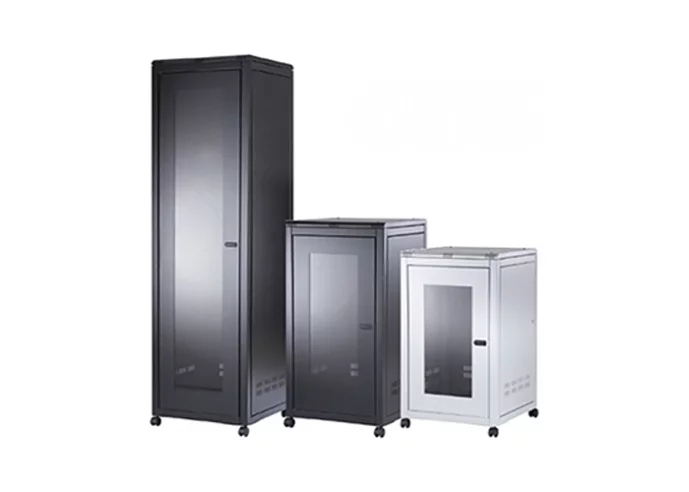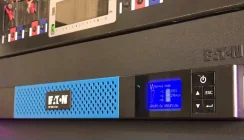Server Rack Cabinets for Pylontech Batteries and Domestic Energy Storage Systems
Pylontech supply a range of lithium-ion energy storage battery packs that can be used in residential energy storage systems in conjunction with a solar PV installation. The battery packs (24Vdc / US2500 and 48Vdc US2000C, US3000C and US5000) are based on 19inch rackmount trays and simply daisy-chain together for communication, with links provided for connecting the batteries into a parallel configuration.
Having a 19inch rack mount format, the battery packs can be housed in a suitable server cabinet, with heavy duty shelving and castors, to provide a secure cabinet with a small footprint. Ideal for domestic applications.
Choosing a Server Cabinet Width and Depth Selection
A standard 600mm wide server cabinet or rack can be used but the depth should be at least 600mm to house the 410mm deep trays. A 600mm deep server cabinet typically has an internal usable depth of 470mm which is sufficient to accommodate the trays and their rear cable connections. A deeper 800mm or longer cabinet can also be used if preferred as these have a maximum internal depth of 670mm.
Selecting a Suitable Server Cabinet Height
The internal height of a server cabinet is measured in U where 1U=44.45mm. When selecting a suitable cabinet, it is important to follow a 3-step process.
Stage 1: Calcualte The Height Required. Summ the total ‘U’ required for the number of Pylontech battery trays to be installed. The Pylontech battery tray heights are:
| Pylontech Model | Height in mm/U |
|---|---|
| US2000C | 88mm / 2U |
| US3000C | 132mm / 3U |
| US5000 | 161mm / 4U |
If you have 3x US5000C battery trays the total U required is 3×4U = 12U. This means you would need a cabinet of at least 12U.
Stage 2: Heavy Duty Shelding. Due to the weight of the battery trays, it is important to place a heavy duty fixed shelf into the cabinets to support them. The battery trays will attach to the front of the server rack frame using M6 cage nuts and bolts. The shelves also fix onto the server rack support struts using the same M6 fixings.
| Pylontech Model | Nett Weight |
|---|---|
| US2000C | 22.5kg |
| US3000C | 32kg |
| US5000 | 39.7kg |
For each shelf allow at least 1U in height. If you have 3x battery trays and 3x shelves, the total U height required is 3×4U = 12U plus 3x 1U = 15U in total plus room for expansion. A suitable cabinet would be the Free Standing 15U 600×600 cabinet if no room for expansion or additional airflow was required.
Stage 3: allow room for expansion and heat. Build-in sufficient space to your server cabinet calculations to allow further Pylontech battery trays and heavy duty shelves to be added later. The more space you have in the cabinet, the better for airflow and to accommodate any heat build/gain from charging/discharging the lithium batteries.
Server Cabinet Access and Installation
Logistics is an important consideration for any server cabinet but more so for one that will be used in a domestic setting. Server cabinets can be supplied fully assembled or as flat packs to be built on site.
A flatpack is supplied with build instructions and the necessary nuts & bolts, and allows the cabinet to be placed within the room the energy storage system will be finally positioned. We would always recommend a solid ground floor installation for any server cabinet, for both ease of access and stability.
The overall height of the cabinet may be important when determining the final position of the cabinet. Care should be taken to ensure that the cabinet has suitable air flow above it (to prevent hot spots) and is clear of any water carrying pipes which could leak onto the cabinet and cause a potential short or fire risk. Ideally a cabinet for energy storage should be placed next to the electrical distribution and AC inverter system.
Castor selection is also important. Heavy duty castors (which can typically take up to 250kg) may be required for the cabinet. This is dependent upon the type and number of battery trays to be installed. Heavy duty castors tend to be lockable.
A suitable cabinet should have lockable mesh front and rear doors or a glass front and mesh door for airflow, and removable sides for access.
A general note on cabinet paint colours is that the most server cabinets are available in either a black or light grey paint as standard. This can be compatible with the colour schemes also used for energy storage battery systems and solar PV inverter systems.
Summary
The principles described above also apply to RESS and BESS battery storage systems for other brands. They have been found to be useful by several clients who have wanted to provide their own cabinet to house their energy storage batteries. Our 19inch server cabinets are ideal for this application as they provide a self-contained and secure cabinet for the Pylontech rackmount battery trays, providing a small footprint for domestic applications.
For a typical installation see this customer review from a client who used a 33U 600×600 server cabinet for their Pylontech installation.


























